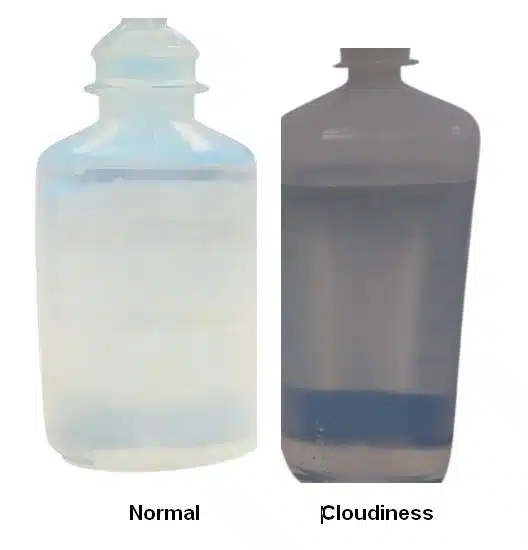After production, cloudiness problem in DNS IV infusion (Intravenous Dextrose Normal Saline) may be a sign of contamination, instability, or other problems that could hazard the product’s safety and effectiveness. The following list of typical causes and their remedies:
Reasons for Cloudiness of DNS IV Infusion
There are many reasons of DNS IV Infusion Post-Manufacturing Cloudiness Problem:
1. Microbial Contamination
Causes:
Cloudiness may be caused by the presence of bacteria, fungus, or other microorganisms. Usually cloudiness is followed by an odd smell or noticeable particles.
Remedies:
1. Strict application of aseptic manufacturing procedures.
2. Frequent microbiological testing of completed goods and raw components.
3. Use the proper sterilization techniques (such as autoclaving or filtration).
2. Precipitation of Salts
Causes:
Precipitation of calcium, magnesium, or other salts due to improper formulation or incompatibility. Cloudiness appears as suspended particles or sediment.
Remedies:
1. Ensure accurate formulation and proper mixing of ingredients.
2. Use of chelating agents to prevent precipitation.
3. Maintain appropriate pH and ionic strength of the solution.
3. Particulate Contamination

Causes:
Presence of foreign particles from manufacturing equipment, containers, or environment. Visual inspection under proper lighting conditions.
Remedies:
1. Implement cleanroom environments and HEPA filtration systems.
2. Regular maintenance and cleaning of manufacturing equipment.
3. Use of high-quality, particle-free raw materials and containers.
4. Chemical Instability
Causes:
Degradation of dextrose or other components due to improper storage or handling. Cloudiness accompanied by changes in color or odor.
Remedies:
1. Store products at recommended temperatures and conditions.
2. Use of stabilizing agents if necessary.
3. Regular stability testing of batches.
5. Incompatibility of Ingredients
Causes:
Incompatibility between dextrose, saline, and other additives leading to cloudiness. Immediate or gradual cloudiness after mixing ingredients.
Remedies:
1. Thorough compatibility testing during formulation development.
2. Avoiding mixing incompatible additives.
3. Use of solubilizers or other techniques to enhance compatibility.
6. Improper Filtration
Causes:
Incomplete filtration allowing particles or microorganisms to remain in the final product. Presence of particles or microbial growth in the fluid.
Remedies:
1. Use of appropriate filtration methods (e.g., membrane filtration) for the specific formulation.
2. Regular validation and testing of filtration systems.
3. Ensuring filters are not compromised and are of the correct pore size.
Read Also: GMP Guidelines for Pharmaceutical Industry
General Preventive Actions for Cloudiness of DNS IV Infusion
Quality Control Test:
Implement robust QC protocols to test for contamination, particulate matter, pH, osmolarity, and sterility.
Good Manufacturing Practice (GMP):
Adhere to GMP standards to ensure cleanliness, proper handling, and documentation.
Training of Employee:
Regular training for staff on aseptic techniques, equipment handling, and quality control procedures.
Environmental Monitoring:
Regular monitoring of the manufacturing environment to detect and mitigate contamination risks.
Conclusion
Cloudiness problem in DNS IV Infusion post-manufacturing is a vital issue that can affect patient safety. By identifying and addressing the root causes through stringent quality control, appropriate manufacturing practices, and preventive measures, manufacturers can ensure the production of clear, safe, and effective IV fluids.
Frequently Asked Questions (FAQs)
1. What is DNS IV infusion?
DNS IV infusion stands for Dextrose Normal Saline Intravenous Infusion. It is a solution containing 5% dextrose (a type of glucose) and 0.9% sodium chloride (salt) in water.
2. What is the use of DNS IV infusion?
This infusion is commonly used to provide hydration, supply essential electrolytes, and deliver a source of calories for energy. It is often administered to patients who are unable to eat or drink adequately due to illness, surgery, or other medical conditions.
3. How is DNS IV infusion administered?
DNS IV infusion is administered intravenously, meaning it is injected directly into a vein. A healthcare professional inserts an IV catheter into a patient’s vein, typically in the arm, and connects it to an IV bag containing the DNS solution. The infusion is then delivered at a controlled rate, which is determined by the patient’s medical condition and fluid requirements.
4. What are the common side effects of DNS IV infusion?
The dangers and adverse effects of DNS IV infusion are relatively low, whereas these results are as follows:
Hyperglycemia: Elevated blood sugar levels due to the dextrose content, especially in diabetic patients.
Fluid overload: Excessive fluid accumulation, which can lead to swelling, high blood pressure, or heart failure, particularly in patients with kidney or heart conditions.
Electrolyte imbalance: Although DNS contains sodium chloride, an imbalance of electrolytes such as potassium and magnesium may still occur.
Infection: Risk of infection at the IV insertion site if proper sterile techniques are not followed.
5. Who should avoid or use caution when receiving DNS IV infusion?
Patients with certain medical conditions should avoid or use caution when receiving DNS IV infusion, including:
Diabetes mellitus: Due to the risk of hyperglycemia.
Kidney disease: Due to the risk of fluid overload and electrolyte imbalances.
Heart failure: Due to the risk of fluid overload.
Severe dehydration: Patients may require more specific electrolyte solutions tailored to their needs.
Before administering a DNS IV infusion, healthcare professionals must assess the patient’s general health as well as their medical history.
6. Is DNS IV infusion safe for long-term treatment?
DNS IV infusion is typically used for short-term therapy to address immediate hydration and nutritional needs. Long-term use is generally avoided unless absolutely necessary, as prolonged administration of dextrose and saline can lead to complications such as hyperglycemia, electrolyte imbalances, and nutritional deficiencies. For patients requiring long-term intravenous nutrition, more comprehensive solutions like total parenteral nutrition (TPN) are often considered, which provide a balanced mix of carbohydrates, proteins, fats, vitamins, and minerals.

Abdus Sobhan Salim is professional experienced pharmacist in pharmaceuticals, author and founder of pharmabossbd.com, the first Bangladeshi pharmaceutical blogger since 2019.



